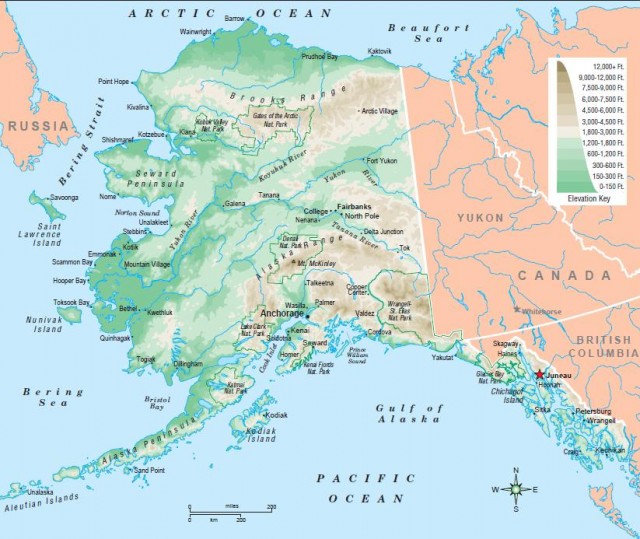The State of Alaska
AT A GLANCE
Name: Alaska comes from an Aleut word meaning “great land.”
Nicknames: Last Frontier, Land of the Midnight Sun
Capital: Juneau
Size: 615,230 sq. mi.
Population: 736 732 (2014)
Statehood: Alaska became the 49th state on January 3, 1959.
Electoral votes: 3 (2016)
U.S. Representatives: 1 (until 2016)
State tree: Sitka spruce
State flower: forget-me-not
State marine mammal: bowhead whale
Highest point: Mount McKinley, 20,320 ft.

THE PLACE
Alaska is the country's largest state. It lies far north of the continental United States and west of Canada. Alaska's three main natural regions are the Coast Ranges, the Interior, and the Arctic.
The Coast Ranges region runs along Alaska's Pacific coast and includes high mountains and many islands. The Interior region is relatively low. The Arctic region contains continuous permafrost, or frozen ground, as well as large deposits of coal, petroleum (oil), and natural gas. During the summer, this area serves as calving grounds for hundreds of thousands of caribou and as nesting grounds for many birds.
Temperatures in Alaska vary greatly according to area. Temperatures remain moderate near the coast, while the interior experiences large differences between winter and summer temperatures. Arctic Alaska is cool year-round and receives very little rain or snow.
Alaska has very few residents and has remained one of the most isolated states in the country. Alaska's petroleum and gas deposits, extensive forests, and minerals make it one of the most economically valuable states.
Facts and Firsts
- Alaska is the largest state of the United States. It is almost one-fifth the size of all the rest of the states combined. Rhode Island, the smallest state, could fit inside Alaska 425 times.
- Mainland Alaska's westernmost tip, Cape Prince of Wales, is only 53 miles from Russia.
- During the summer, the sun shines for extended hours; in Anchorage, the sun does not set until
approximately 10:42 P.M. - There are more than 100,000 glaciers in Alaska.
- Approximately 25 percent of all oil produced in the United States comes from Alaska.
- Alaska's capital, Juneau, is the sole capital city in the United States accessible only by boat or plane.
- The United States paid $7.2 million for Alaska in 1867, which is two cents per acre.
- The Aleutian islands of Agattu, Attu, and Kiska were the only parts of North America occupied by Japanese troops during World War II.
THE PAST
The first people to reach Alaska came over a land bridge that once connected Alaska's western tip to Asia. In 1741, Vitus Bering, a Danish adventurer working for Russia, explored parts of Alaska's mainland and several islands. Alaska was still mostly unknown in 1867, when the United States bought it from Russia. In the late 1890s, however, more than 30,000 people rushed into Alaska determined to find gold.
Alaska became a state on January 3, 1959. After the state's gold was depleted, interest in Alaska declined until 1968, when a large oil and gas deposit was discovered near Prudhoe Bay on the Arctic coast. Since then, many other major oil and natural gas deposits have been found in Alaska. In 1977, the nearly 800-mile-long Trans-Alaska Pipeline, which carries Alaskan oil throughout the state, was completed. In 1989, the oil tanker Exxon Valdez ran aground in Prince William Sound, causing the biggest oil spill in U.S. history and a major ecological disaster.
THE PRESENT
Alaska is famous for its size, beauty, and natural resources. Alaska contains the largest known North American oil field.
The question of whether or not to drill for oil in Alaska's national parks has sparked fierce debate. Natural gas is also an important resource for the state, as are fish and other seafood. Alaska produces most of the salmon, crab, halibut, and herring consumed in the United States.
Despite its industrial and commercial importance, Alaska remains the state with the lowest population density. Alaska's scenery and wilderness make it a popular tourist destination. However, the state has remained closely tied to its past. Alaska is home to a number of different Native American groups, and dogsled racing is the official state sport.
Alaska's natural beauty, sense of history, and untouched wilderness have earned the state the nickname the Last Frontier.
Born in Alaska
- Irene Bedard, actress
- Benny Benson, child designer of state flag
- Scott Gomez, hockey player
- Virgil F. Partch, cartoonist
- Elizabeth Peratrovich, political activist
- Curt Schilling, baseball player